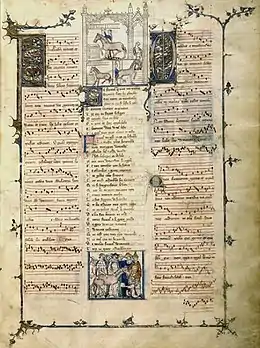Magister Franciscus (fl. 1370–80) was a French composer-poet in the ars nova style of late medieval music. He is known for two surviving works, the three-part ballades: De Narcissus and Phiton, Phiton, beste tres venimeuse; the former was widely distributed in his lifetime.[1] Modern scholarship disagrees on whether Franciscus was the same person as the composer F. Andrieu.
Identity career
Franciscus may be the same person as the F. Andrieu who wrote Armes, amours/O flour des flours, a déploration on the death of poet-composer Guillaume de Machaut (c. 1300–1377).[2] Although, the scholarly consensus on this identification is unclear.[n 1] He may also be Franciscus de Goano or Johannes Franchois.[1] Machaut was the most dominant and important composer of the 14th century,[3] and Franciscus's works show many similarities to his, suggesting the two were contemporaries.[1]
Music
Only two of his works survive, the three-part ballades: De Narcissus and Phiton, Phiton, beste tres venimeuse.[1] They are both contained in the Chantilly Codex.[4] Reaney notes that Magister Franciscus's works are likely earlier than Andrieu's, between 1370 and 1376.[5]
Works
| Title | No. of voices | Genre | Manuscript source: Folios | Apel | Greene |
|---|---|---|---|---|---|
| De Narcissus | 3 | Ballade | Chantilly Codex: 19v | A 26 | G Vol 18: 16 |
| Phiton, Phiton, beste tres venimeuse | 3 | Ballade | Chantilly Codex: 20v | A 27 | G Vol 18: 18 |
| No other works by Magister Franciscus survive[n 2] | |||||
Editions
Franciscus's works are included in the following collections:
- Apel, Willi, ed. (1970–72). French Secular Compositions of the Fourteenth Century. Corpus mensurabilis musicae. Vol. 53. Cambridge, Massachusetts: American Institute of Musicology. ISBN 9780910956291. OCLC 311424615.
- Greene, Gordon K., ed. (1982). Manuscript Chantilly, Musée Condé 564 Part 1, nos. 1–50. Polyphonic Music of the Fourteenth Century. Vol. 18. Monaco: Éditions de l'Oiseau-Lyre. OCLC 181660103.
Recordings
| Year | Album | Performers | Piece | Label |
|---|---|---|---|---|
| 1950 or before | Monuments of the Ars Nova, vol. 102 | Various | De Narcissus | Oiseau-Lyre OL 102 |
| 1973 | The Late 14th Century Avant Garde | Early Music Consort of London | Phiton, Phiton, beste tres venimeuse | EMI/HMV ASD 3621 |
References
Notes
- ↑ Scholars identify F. Andrieu as Magister Franciscus with varying degrees of certainty:
- Reaney 2001: Their works being from the same manuscript "suggest that the two composers may be the same person".
- Abraham & Hughes 1960, p. 27: "Franciscus is doubtless the same man as the F. Andrieu..."
- Reaney 1954, p. 67: "It would not be impossible for Magister Franciscus and F. Andrieu to be one and the same person"
- Günther 2001: "[Magister Franciscus] may be the F. Andrieu..."
- Strohm 2005, p. 53: "[F. Andrieu] may be the same man as Magister Franciscus"
- Magnan 1993, p. 49: "[On the identification between Andrieu and Franciscus] this tenuous identification leads nowhere."
- ↑ If Magister Franciscus is identifiable with F. Andrieu, then Andrieu's compositions would be his as well.
Citations
- 1 2 3 4 5 Günther 2001.
- 1 2 Reaney 2001.
- ↑ Reese 1940, p. 359.
- ↑ Abraham & Hughes 1960, p. 27.
- ↑ Reaney 1954, p. 67.
- ↑ "Recordings of works by Magister Franciscus". lib.latrobe.edu.au. La Trobe University. Retrieved 13 July 2022.
Sources
- Books
- Abraham, Gerald; Hughes, Dom Anselm, eds. (1960). Ars Nova and the Renaissance 1300-1540. The New Oxford History of Music. Vol. III. Oxford: Oxford University Press. ISBN 978-0-19-316303-4.
- Reese, Gustave (1940). Music in the Middle Ages: With an Introduction on the Music of Ancient Times. Lanham: W. W. Norton & Company. ISBN 978-0-393-09750-4.
- Strohm, Reinhard (2005). The Rise of European Music, 1380-1500. Cambridge: Cambridge University Press. ISBN 978-0-521-61934-9.
- Journals and articles
- Günther, Ursula (2001). "Franciscus, Magister". Grove Music Online. Oxford: Oxford University Press. doi:10.1093/gmo/9781561592630.article.10117. ISBN 978-1-56159-263-0. (subscription or UK public library membership required)
- Magnan, Robert (1993). "Eustache Deschamps and his Double: Musique naturele and musique artificiele". Ars Lyrica. New Haven: Brepols. 7: 47–64. eISSN 2507-0398. ISSN 1043-3848.
- Reaney, Gilbert (1954). "The Manuscript Chantilly, Musée Condé 1047". Musica Disciplina. 8: 59–113. JSTOR 20531876.
- Reaney, Gilbert (2001). "Andrieu, F.". Grove Music Online. Oxford: Oxford University Press. doi:10.1093/gmo/9781561592630.article.00904. ISBN 978-1-56159-263-0. (subscription or UK public library membership required)
- Wilkins, Nigel (1968). "The Post-Machaut Generation of Poet-Musicians". Nottingham Medieval Studies. Turnhout: Brepols. 12: 40–84. doi:10.1484/J.NMS.3.38.
External links
- List of compositions by Magister Franciscus at the Digital Image Archive of Medieval Music
- Works by Magister Franciscus in the Medieval Music Database from La Trobe University
